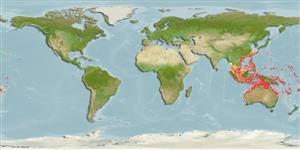Environment: milieu / climate zone / depth range / distribution range
Ecologie
marien rifbewoner; diepte 2 - 100 m (Ref. 37816). Tropical; 29°N - 34°S, 96°E - 170°W (Ref. 5222)
Pacific Ocean: Cocos-Keeling Islands to Samoa, north to southern Japan, south to southeastern Australia and Lord Howe Island (Ref. 37816).
Lengte bij maturiteit / Grootte / Gewicht / Leeftijd
Maturity: Lm ?, range 35 - ? cm
Max length : 60.5 cm TL mannelijk / geslacht onbekend; (Ref. 5525)
Dorsale stekels (totaal) : 11; Dorsale zachte stralen (totaal) : 15 - 17; Anale stekels: 3; Anale zachte stralen: 8. Brown spots evenly distributed and packed into hexagonal shapes only on adults which are generally larger (>25 to 45 cm); front portion of spinous dorsal fin about 50% taller than on other species at all sizes (Ref. 37816); small juveniles black with white blotches, becoming more spotted with age (Ref. 48635); further characterized by having ctenoid scales on body; auxiliary scales on body; greatest depth of body 2.7-3.1 in SL; rounded caudal fin; pelvic fins 1.7-2.0 in head length (Ref. 90102); head length 2.4-2.6 times in SL; flat to slightly convex interorbital area, convex dorsal head profile; preopercle with shallow indentation just above the enlarged serrae at angle; straight or slightly convex upper edge of operculum, posterior and anterior nostrils subequal; maxilla reaches to or past vertical at rear edge of eye, ventral edge with blunt hook-like process distally in fish larger than 35 cm SL; 2 rows of teeth on midlateral part of lower jaw (Ref. 89707).
Juveniles are found in shallow coral rubble, adults in isolated coral heads of lagoon and seaward reefs to depths of 82 m. Feeds mainly on sand-dwelling fishes and crustaceans, sometimes on octopuses. In the Hong Kong live fish markets (Ref. 27253). May be ciguatoxic in certain areas (Ref. 37816). Solitary, often seen on open sand and base of reefs (Ref 90102).
Levenscyclus en paargedrag
Maturiteit | Voortplanting | Paaien | Eieren | Fecunditeit | Larven
Heemstra, P.C. and J.E. Randall, 1993. FAO Species Catalogue. Vol. 16. Groupers of the world (family Serranidae, subfamily Epinephelinae). An annotated and illustrated catalogue of the grouper, rockcod, hind, coral grouper and lyretail species known to date. Rome: FAO. FAO Fish. Synop. 125(16):382 p. (Ref. 5222)
Status op de Rode Lijst van het IUCN (Ref. 130435: Version 2024-2)
Gevaar voor de mens
Reports of ciguatera poisoning
Gebruik door de mens
Visserij: van minder commercieel belang; Aquarium: Publieke aquaria
Tools
Speciale rapporten
Download XML
Internetbronnen
Estimates based on models
Preferred temperature (Ref.
123201): 24.3 - 28.8, mean 27.6 °C (based on 698 cells).
Fylogenetische diversiteitsindex (Ref.
82804): PD
50 = 0.5000 [Uniqueness, from 0.5 = low to 2.0 = high].
Bayesian length-weight: a=0.01096 (0.00703 - 0.01709), b=3.01 (2.88 - 3.14), in cm total length, based on LWR estimates for this species & Genus-body shape (Ref.
93245).
Trofisch niveau (Ref.
69278): 4.0 ±0.4 se; based on diet studies.
Generation time: 3.9 ( na - na) years. Estimated as median ln(3)/K based on 2
growth studies.
Weerstandsvermogen (Ref.
120179): Gemiddeld, minimale populatieverdubbelingstijd 1,4-4,4 jaar (K=0.28).
Fishing Vulnerability (Ref.
59153): Low to moderate vulnerability (29 of 100).
Nutrients (Ref.
124155): Calcium = 30.4 [15.3, 63.6] mg/100g; Iron = 0.616 [0.310, 1.274] mg/100g; Protein = 18.6 [17.0, 20.0] %; Omega3 = 0.13 [0.08, 0.21] g/100g; Selenium = 42.7 [22.8, 86.5] μg/100g; VitaminA = 186 [49, 696] μg/100g; Zinc = 1.06 [0.72, 1.57] mg/100g (wet weight);
